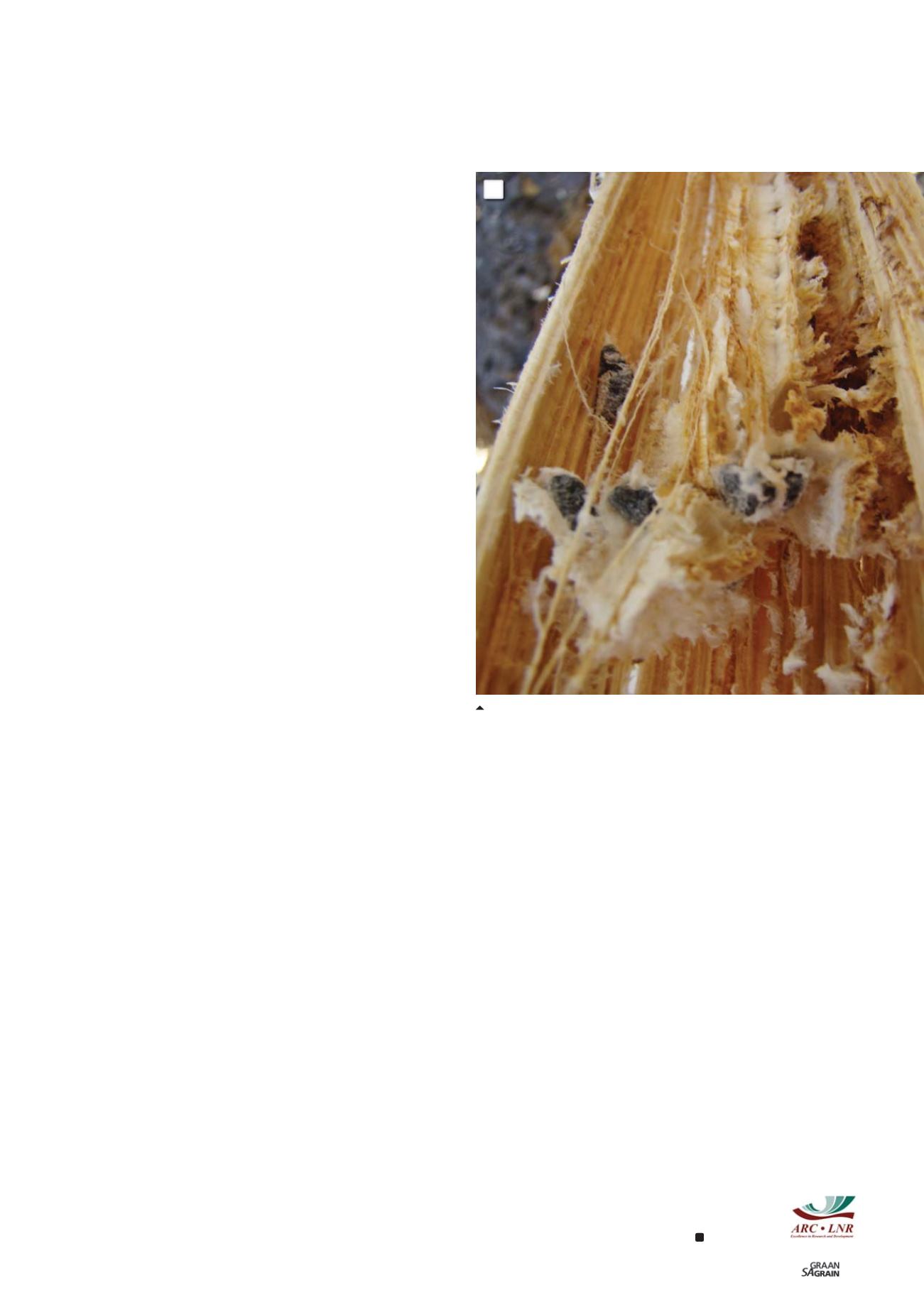

91
and enable rapid ramification of the fungus throughout the head.
Wounds on the back of the sunflower heads may become infection
sources and initiate head rot.
Control
Management
Outbreaks of sunflower head rot may result in infestation of lands
previously free or with low levels of Sclerotinia. These infestations
restrict the producers’ options in terms of alternate crops to be used
in rotation systems with maize, due to the wide host range infected
by Sclerotinia.
The infested fields are a threat to sunflower, which may be planted
again after a season’s maize, since Sclerotinia stem rot may occur
irrespective of weather conditions. The suggested norm is to avoid
planting sunflowers on infested fields for five to eight years.
Under local production conditions this may entail planting maize un-
der monoculture for at least five seasons. Rotation will reduce stem
rot more significantly than head rot. Head rot can still develop from
windborne spores blown in from surrounding areas.
Deep burial of sclerotia prevents them from producing apothecia.
One must avoid bringing these buried sclerotia to the surface in fol-
lowing seasons. Once they return to the soil surface and are still vi-
able they can again cause disease. Deep burial and planting of other
carefully selected non-host crops in rotation with maize will reduce
inoculum.
Resistance
Tolerance to stem and head rot does occur. In the USA (North Da-
kota) genotypes are screened annually. Genotypes may be tolerant
to head rot and not stem rot and vice versa.
No genotype is resistant. Tolerance is influenced by weather condi-
tions. Locally, genotypes need to be screened and mechanisms of
tolerance need to be determined for significant progress to be made
for use in local management systems.
Chemical control
Desiccants that result in early dry down may be sprayed on the crop
after physiological maturity to reduce the impact of further develop-
ment of Sclerotinia head rot and sclerotial development.
Ensuing weather conditions may influence the efficacy of desiccants
as wet weather may favour head rot after the plants have dried due
to their affinity for dead tissue. Future weather conditions need to
be forecasted prior to a decision regarding use of desiccants can
be made.
Benomyl as a seed treatment is the only currently registered fungi-
cide on sunflowers in South Africa. Procymidone is registered on
soybeans as a spray, but timing of the spray is critical and for sun-
flowers there are serious economic implications should it ever be
registered. This aspect needs to be thoroughly researched before
being included in management systems.
Biological control
Bayer has a biocontrol product on the market called Contans, which
is a fungus,
Coniothyrium minitans
. Contans is made up of spores
of this biocontrol fungus that attacks the sclerotia whilst still in the
ground prior to them developing apothecia.
The earlier the product can be applied to fields known to have previ-
ous Sclerotinia head rot outbreaks the more efficient it becomes.
Broadleaf weed and volunteer
sunflower control
Control of broadleaf weeds and volunteer sunflowers reduces
possible inoculum increase by reducing possible alternate hosts
of Sclerotinia.
Planting
Plant sunflowers early to avoid wet, cool conditions during flower-
ing to reduce head rot infections. Avoid planting sunflowers next
to infested fields that could be a source of spores. Plant clean sun-
flower seeds as infected seed may be a primary source of inoculum
in uninfected fields.
Summary
Sclerotinia head and stem rot are a significant threat to the local
sunflower industry – particularly in wet seasons. Recent surveys
done by the ARC have shown that epidemics are sporadic over sea-
sons and localities. Although a lot of research has been done on this
disease, very few management solutions have been developed.
Research on tolerance, mechanisms of tolerance, chemical control
and timing thereof with use of prediction models need to be re-
searched. It is critical to reduce the threat of Sclerotinia in local crop
production due to its wide host range and ability to survive.
Increased occurrence and incidence of this pathogen on susceptible
hosts will also impact on the maize industry in reduc-
ing options for maize crop rotation systems as well as
impact on the maize price should large areas of arable
land be planted to monoculture maize.
2: Large black sclerotia develop below the seed layer and around the
seeds.
Photo: Dr André Nel, ARC-Grain Crops
2
March 2018
















